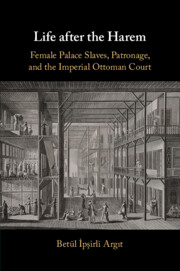Book contents
- Life after the Harem
- Life after the Harem
- Copyright page
- Dedication
- Contents
- Illustrations
- Maps
- Graphs
- Tables
- Acknowledgments
- Note on Usage
- Abbreviations
- Introduction
- 1 The Imperial Harem and Its Residents
- 2 Departure from the Imperial Palace and Changing Relationships with the Imperial Court
- 3 Marriage Patterns
- 4 Residential Districts and Relations with Society
- 5 Material World: Fortunes and Possessions
- 6 Charitable Activities: Architectural Patronage and Endowments
- Conclusion
- Appendix Residential Neighborhoods of Palace Women in intra muros Istanbul
- Bibliography
- Index
3 - Marriage Patterns
Published online by Cambridge University Press: 08 October 2020
- Life after the Harem
- Life after the Harem
- Copyright page
- Dedication
- Contents
- Illustrations
- Maps
- Graphs
- Tables
- Acknowledgments
- Note on Usage
- Abbreviations
- Introduction
- 1 The Imperial Harem and Its Residents
- 2 Departure from the Imperial Palace and Changing Relationships with the Imperial Court
- 3 Marriage Patterns
- 4 Residential Districts and Relations with Society
- 5 Material World: Fortunes and Possessions
- 6 Charitable Activities: Architectural Patronage and Endowments
- Conclusion
- Appendix Residential Neighborhoods of Palace Women in intra muros Istanbul
- Bibliography
- Index
Summary
The vast majority of manumitted female palace slaves who left the imperial harem later married. Just as the Enderun prepared men to serve the dynasty outside the palace, the protocol, etiquette, and training provided to female slaves in the imperial harem prepared them for their future role in the outside world. Chapter 3 examines the women’s marriage patterns and asks the question: To what extent did palace affiliation impact their marriages? An analysis of the social and professional profile of the husbands shows that a great majority of the women married members of the askeri class, and that these marriages had strategic and symbolic importance for the imperial household. It traces the implications of their marriages for the women themselves, for their husbands, and for the imperial court in the sociopolitical context of the era. The chapter demonstrates that by way of marriage, women’s affiliation to the imperial court took on a different form, and they continued to play a role, albeit a new one, in the political structure.
- Type
- Chapter
- Information
- Life after the HaremFemale Palace Slaves, Patronage and the Imperial Ottoman Court, pp. 108 - 135Publisher: Cambridge University PressPrint publication year: 2020

